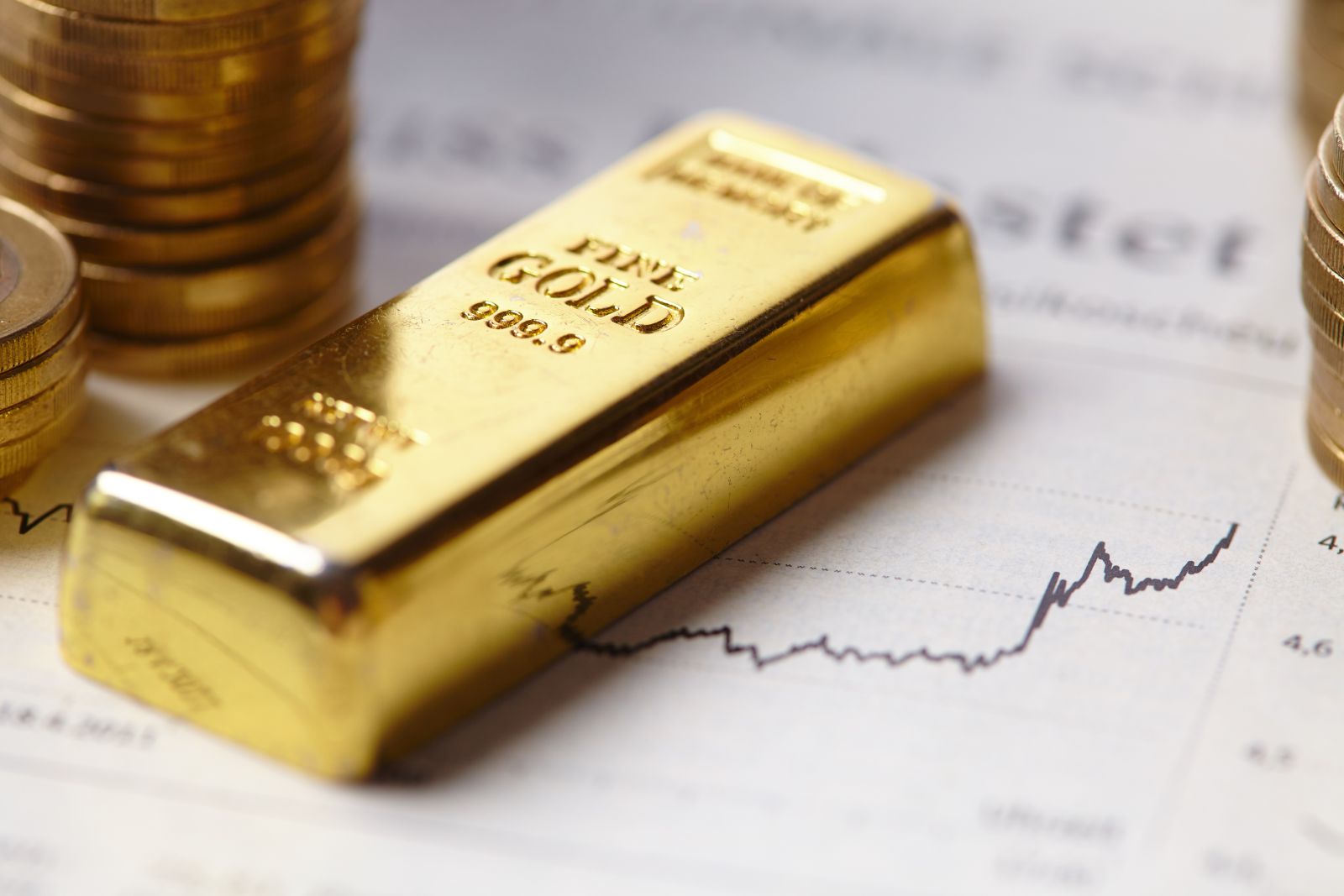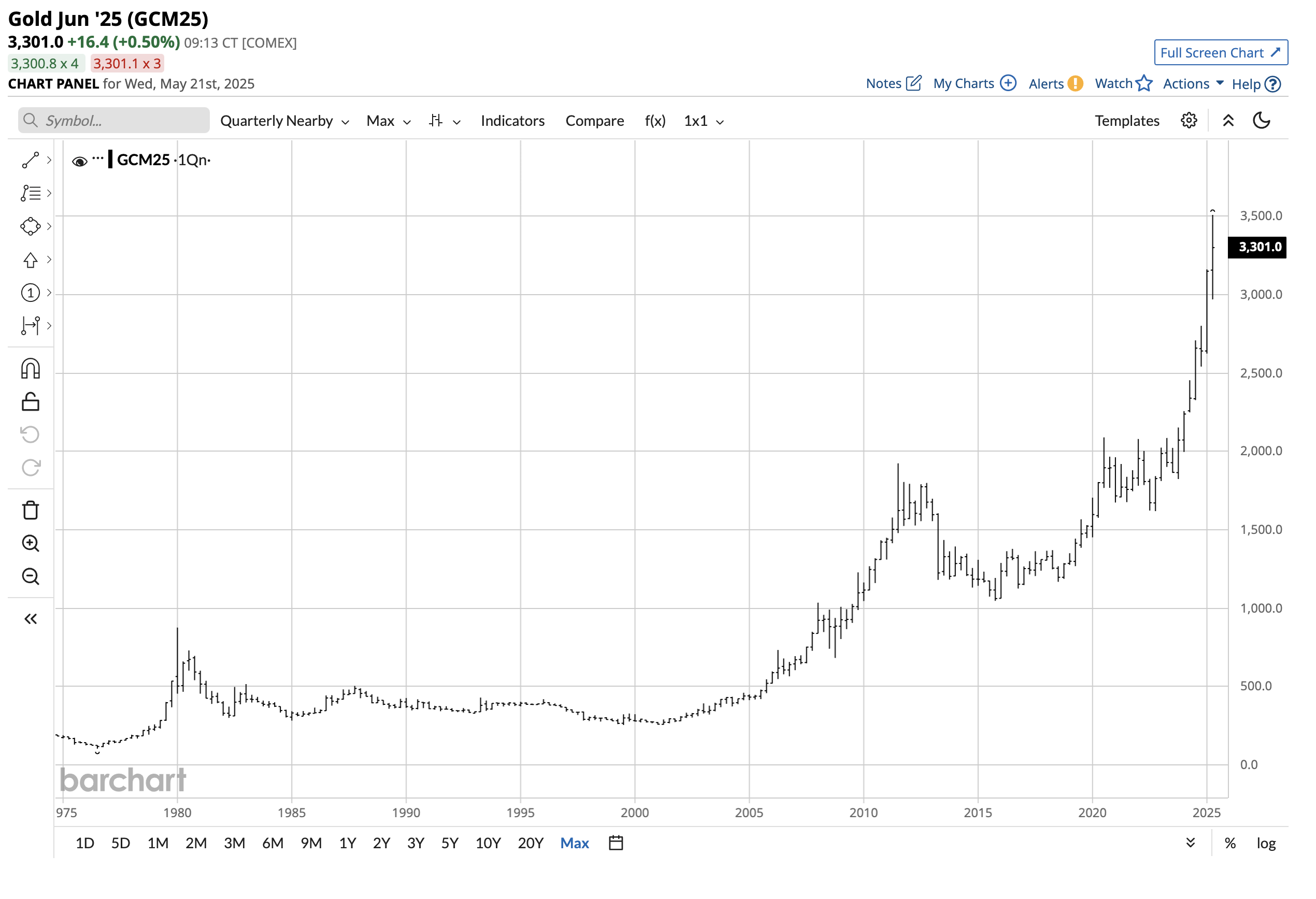Gold Corrects- Are Higher Highs on the Horizon?

I asked if gold would make a new high in an April 1 Barchart article. Nearby COMEX gold futures were at the $3,156 per ounce level on March 31, when I wrote:
Gold could pull back from the most recent high, but the bull market, now twenty six years old, shows no sign of faltering while fiat currency values dissipate. Gold is likely to continue to make new highs in April as it closes in on its inflation-adjusted target from the 1980 high at the $3,400 per ounce level.
June COMEX gold futures eclipsed the inflation-adjusted target from the 1980 high at $3,400 per ounce, rising to over $3,500 before pulling back. However, the long-term bullish trend continues as gold makes higher lows and higher highs.
A new high and a pullback
COMEX gold futures reached the most recent record high on April 22, 2025, when the price reached $3,509.90 per ounce.

The daily chart shows that the June gold futures corrected 11% to the most recent May 15, 2025, low of $3,123.30 per ounce. Short-term technical support is at the April 7 $2,970.40 low with resistance at the April 22 high.
Gold’s bull market began in 1999 at $252.50 per ounce. Over the past twenty-six years, gold has made higher lows and higher highs, experiencing periodic corrections. Even the most aggressive bull markets rarely move in straight lines.

The quarterly chart highlights many double-digit percentage corrections over the past years.
Analysts are adjusting their upside gold targets
Gold’s ascent has caused analysts at the leading financial institutions to adjust their price forecasts higher. Analysts at JP Morgan recently projected that gold could reach $6,000 per ounce if there is even a slight shift away from U.S. assets.
Goldman Sachs analyst Lina Thomas moved their gold forecast for the end of 2025 from $3,100 to $3,300 in late March. Gold has already eclipsed the forecast price.
Forecasts will likely chase gold higher if the metal’s price continues its upward trajectory.
Sentiment remains bullish, which could be bearish
Gold’s price was 27.47% higher in 2024, after rising over 11% in 2023. In Q1 2025, gold prices rallied another 18.24%. The substantial gains over the past years that took gold to new highs have caused an investment gold rush, leading to wildly bullish sentiment. In many markets, too many bulls tend to lead to substantial price corrections, as corrections can lead to a herd of long liquidation.
However, gold is a unique asset, with central banks and governments major players in the gold arena. The official sector has continued to purchase gold, adding to reserves as they consider gold a foreign currency reserve. In Q1 2025, higher prices did not deter central banks from increasing their gold stockpiles, which rose by 244 metric tons or nearly 7.85 million ounces.

While overly bullish sentiment could lead to further price declines, the trend of increasing central bank gold demand suggests they will step up and buy during any substantial price corrections.
High longer-term interest rates and a weak U.S. dollar are competing factors
U.S. interest rates remain elevated in May 2025.

The trend in the U.S. 30-year Treasury Bond futures remains bearish, with the long bond futures around 112, which is not far above the October 2023 107-04 low and critical technical support level. Meanwhile, short-term rates remain high, with the Fed Funds Rate at a midpoint of 4.375% after the Fed cited tariff-related factors for not reducing rates at the May FOMC meeting.
Higher interest rates tend to weigh on gold prices because they increase the cost of carrying gold inventories, and higher rates attract capital to the fixed-income bond market and away from other assets, including gold.
Meanwhile, the price action in the dollar index has supported higher gold prices.

The daily chart of the U.S. dollar index in 2025 shows the 11.12% decline from the January 2025 high of 110.17 to the April 21, 2025, low of 97.92. The dollar index reached its low around the time gold prices peaked. Since the U.S. dollar is the pricing mechanism for the international gold market, a weak dollar tends to support prices while a stronger dollar has the opposite effect. The index has rallied back to over the 100 level in late May 2025, weighing on gold prices, which have declined from the most recent high.
Gold’s ascent is a commentary on the economic and geopolitical landscapes
Gold’s ascent this century has been incredible, rising nearly fourteen times from the 1999 low. However, gold’s role as the world’s oldest means of exchange tells us that fiat money’s value is declining, as gold has made new record highs in all currency terms.
Moreover, gold has a long history as flight capital, rising in times of geopolitical turmoil. Wars in Ukraine, the Middle East, and the bifurcation of the world’s nuclear powers have supported higher gold prices. Meanwhile, as the U.S. dollar’s role as the world’s reserve currency declines, many governments have added to gold reserves, which are likely understated. Russia and China, two countries that are leading gold producers, have likely vacuumed up domestic production, bolstering their reserves. Since strategic reserves are state secrets in Russia and China, the data probably does not filter through to the official reserve reports.
The bottom line is that technical and fundamental factors point to even higher gold prices over the coming months and years, supported by significant global economic and geopolitical changes. Buying gold during a correction has been optimal for over a quarter of a century, and I expect that trend to continue over the coming years.
On the date of publication, Andrew Hecht did not have (either directly or indirectly) positions in any of the securities mentioned in this article. All information and data in this article is solely for informational purposes. For more information please view the Barchart Disclosure Policy here.